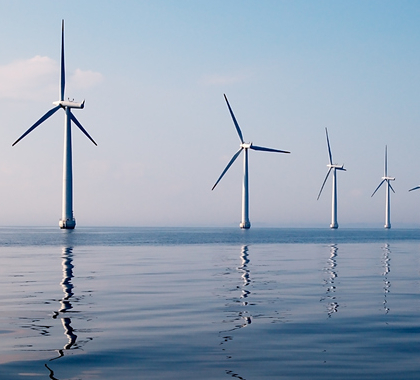Commercial fishing companies, trade groups, and seaport communities in four states are fighting against the development of a massive offshore windfarm planned to be built in the Atlantic Ocean.
The group is requesting courts block the U.S. Department of the Interior’s Bureau of Ocean Energy Management (BOEM) from auctioning the rights to develop the project. The coalition, which includes the cities of Narragansett, Rhode Island and New Bedford, Massachusetts, filed a petition to block the lease in federal court in Washington, DC in early December 2016, arguing BOEM offered the lease without adequately considering the harm to the fishermen who have traditionally worked the area for scallops and squid.
On December 16, the court provisionally allowed the auction to proceed. Norwegian state-owned oil company Statoil won, paying approximately $42.5 million for the right to build a wind farm with as many as 194 turbines across nearly 80,000 acres in the ocean off the coasts of New Jersey and New York.
The group amended its lawsuit, asking the court to provide a temporary restraining order and preliminary injunction to prevent BOEM taking the necessary next step with the provisional lease. The court agreed to consider the motion, setting February 8, 2017, as the date to hear the plaintiffs’ arguments.
Concerns of Fishermen Ignored
The lawsuit claims the Obama administration officials at BOEM did not properly account for the impact the wind farm would have on commercial fisheries in the region, including the harm to marine life from noise that will be made when sinking the supports into the ocean bed.
“This will have a negative impact on pretty much anything with a swim bladder,” said Bob Vanasse, spokesman for the Fisheries Survival Fund (FSF). “The scallop industry and the squid industries would be harmed.”
Vanasse says the plaintiffs are not opposed to all windfarms.
“This isn’t a question of opposing wind farms; it’s a question of opposing the way BOEM went about locating this particular wind farm,” Vanasse said. “There is a right way to do it that takes into account all the uses of the ocean, and there’s the wrong way to do it, which does not.
“Many of the people who were active on this lawsuit were active in the placement of leases off of Massachusetts, Nantucket, Martha’s Vineyard, and Block Island,” said Vanasse. “The issue here is how the site was selected for the lease and how it will harm marine life.”
Council Process Bypassed
Vanasse notes this is not the first fisheries decision made by the Obama administration FSF has fought. FSF also objected to President Barack Obama’s decision to expand the Papahānaumokuākea Marine National Monument around Hawaii in August 2016 and declare the Northeast Canyons and Seamounts Marine National Monument in the Atlantic Ocean in September 2016, claiming in both instances the Obama administration failed to follow the proper procedures and consider the impact the monument declarations would have on fisheries.
“This isn’t about the benefits or lack of benefits of protecting ocean resources; this is about how you do it,” Vanasse said. “There are deliberative public processes in place to manage fisheries and sanctuaries, including the 1972 National Marine Protection, Research, and Sanctuaries Act; the 1972 Marine Mammal Protection Act; and the 1976 Magnuson–Stevens Fishery Conservation and Management Act.
“Environmental organizations pushed the Obama administration to expand the monument in the Pacific and create the monument in the Atlantic, going around the council process,” said Vanasse. “To use the 1906 Antiquities Act to go around the process and create monuments was completely wrong, resulting, for example, in moving the tuna fishermen in New Jersey off of their historic grounds for no good reason.”
A Lot to Lose
Drew Minkiewicz, an attorney representing the plaintiffs, says although the wind farm may not affect the global cost of squid and scallops, it will harm the local fishers.
“Because it’s a global marketplace, it’s hard to say this wind farm will move the needle one way or another regarding the price of seafood, but it will take dollars from lost catch out of the hands of those fishermen who have always fished there,” Minkiewicz said. “They have a lot to lose. The building of these windfarms is incompatible with fishing with nets or dredging for squid, scallops, or anything else.
“There was very little analysis done concerning the impact of this lease on fisheries,” Minkiewicz said. “The nearest turbine is 12 miles off the coast of Long Island, so they avoided stirring up the ‘Not In My Back Yard’ interests,” said Minkiewicz. “They won’t inconvenience wealthy coastal land owners, but they will impact the fishing grounds. That was the choice they made.”
Environmental Impact of Wind Power
James Taylor, president of the Spark of Freedom Foundation, says the move to harness wind power off the coast of Long Island shows all forms of energy development affect the environment.
Although wind and solar power emit no air pollution, they have other environmentally devastating effects, Taylor says.
“Nuclear power and hydro power emit no emissions, and they are much more valuable as on-demand, economical energy sources,” Taylor said. “Natural gas emits only a small amount of emissions, and it is abundant and affordable.
“We will be far better off when government stops subsidizing and mandating wind power and allows other more-affordable and green power sources to compete on equal footing,” said Taylor.
Kenneth Artz ([email protected]) writes from Dallas, Texas.





